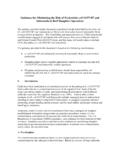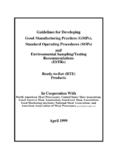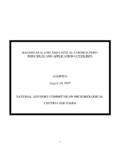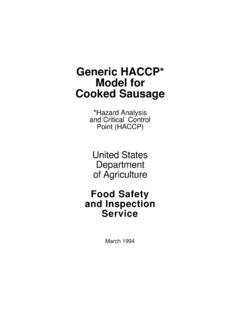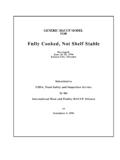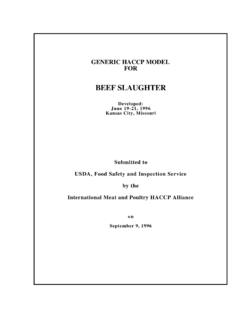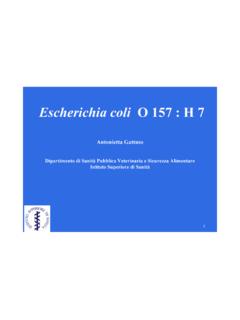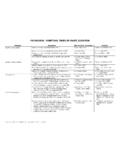Transcription of TABLE OF CONTENTS - HACCP Alliance
1 TABLE OF I - Overview of Biological, Chemical, and Physical 1 - Characteristics of Growth for Nine Pathogens Associated with Meat and Poultry Hazards ..D-6 TABLE 2 - Types of Chemical 3 - Types of Physical II - Controls and Critical Limits for Biological, Chemical, and Physical 4 - Examples of Preventive Measures for Biological 5 - Examples of Preventive Measures for Chemical 6 - Examples of Preventive Measures for Physical 7 - Some Examples of Regulatory III - Red Meat (Beef) Slaughter Hazards and 8 - Red Meat Slaughter: IV - Red Meat (Swine) Slaughter Hazards and 9 - Red Meat Slaughter: V - Poultry Slaughter Hazards and 10 - Poultry VI - Ingredient Hazards and Ingredient - Related 11 - Ingredient and Ingredient - VII - Processing Hazards and 12 - VIII - Hazard Analysis Critical Control Point , Chemical, and Physical Home D-1 PREFACEThis Guide is designed to help a plant s HACCP team conduct a hazard analysis (HACCPP rinciple 1) by providing both general and detailed information on hazards associated with meatand poultry products and by listing some of the controls that can be used to prevent or managethose hazards.
2 When using this Guide, it is very important to remember that it is not all-inclusive:there may be other hazards associated with ingredients or processes and there may be othercontrol measures. The examples assembled here are to help plant HACCP teams think through allthe hazards that could affect their product and know about various controls that can be I describes some of the biological (including microbiological), chemical, and physicalhazards generally recognized and associated with meat and poultry products. This section canserve as a resource when the HACCP team begins the hazard analysis. It is probably useful toread through this general information early in the process of developing the HACCP plan. Thiswill help the team form an idea of what is meant by a given II provides information on generally recognized preventive measures used in the meat andpoultry industry to control biological, chemical, and physical hazards.
3 This section also hasexamples of regulatory critical limits associated with some preventive III, IV, and V list processing steps, hazards, and controls for beef, swine, and poultryslaughter. This section should be used with the process flow diagram developed by the VI presents hazards and controls organized according to ingredients, including both meatand poultry ingredients and other ingredients used in meat and poultry production. This sectionshould be used with the list of ingredients developed by the HACCP team. Section VII contains a set of tables identifying potential hazards at various processing steps usedto produce meat and poultry products. This section should be used with the process flow diagramdeveloped by the plant s HACCP team. Section VIII contains a list of valuable references that will help the plant s HACCP team furtherdevelop the HACCP plan.
4 D-2 SECTION IOVERVIEW OF BIOLOGICAL, CHEMICAL, AND PHYSICAL HAZARDSIn a HACCP system, a hazard is defined as a biological, chemical, or physical property that maycause a food to be unsafe for human consumption. This guide is a reference for plant HACCP teams to use in their hazard identification and analysis. It is not intended to be totally inclusive;the team may have other information or may rely on additional HAZARDSB iological hazards, mainly bacterial, can cause either foodborne infections or intoxications. Afoodborne infection is caused by a person ingesting a number of pathogenic microorganismssufficient to cause infection as a result of their multiplication, , salmonellosis. A foodborneintoxication is caused by the ingestion of preformed toxins produced by some bacteria when theymultiply and release toxin into the food product, , staphylococcal pathogenic bacteria are frequently implicated in foodborne illness and should be consideredin assessing hazards to human health from the consumption of meat and poultry products.
5 Thefollowing identifies and discusses the nine pathogenic microorganisms of cereusB. cereus causes foodborne illness. There are two types of toxins - diarrheal and emetic(vomiting). Foods associated with illness include: boiled and fried rice, custards, cereal products, meats, vegetables, and fish; food mixtures such as sauces, puddings, soups, casseroles, pastries, andsalads. Campylobacter jejuniCampylobacteriosis is the illness caused by C. jejuni. It is also often known as campylobacterenteritis or gastroenteritis. Food associated with illness include: raw and undercooked chicken, and raw milk. Clostridium botulinumFoodborne botulism (as distinct from wound botulism and infant botulism) is a severe foodbornedisease caused by the ingestion of foods containing the potent neurotoxin formed during growthof the organism. Botulism has a high mortality rate if not treated immediately and properly.
6 D-3 Foods associated with disease include: meat products, such as sausages, seafood products,improperly canned foods, and vegetable products. Clostridium perfringens Perfringens foodborne illness is the term used to describe the common foodborne disease causedby the release of enterotoxin during sporulation of C. perfringens in the gut. Foods associated with illness include: meat and poultry products and gravy. Escherichia coli O157:H7 Hemorrhagic colitis is the name of the acute disease caused by E. coli O157:H7. Foods associated with illness include: undercooked or raw hamburger (ground beef); in sporadiccases, other meat products and raw monocytogenesListeriosis is the name of the general group of disorders caused by L. associated with illness include: cole slaw, cooked poultry, cooked meat, and raw milk,supposedly pasteurized fluid milk, and cheeses (particularly soft-ripened varieties).
7 Its ability togrow at temperatures as low as 3C permits multiplication in refrigerated foods. oSalmonella typhi and the paratyphoid bacteria are normally septicemic and produce typhoid or typhoid-likefever in humans and are predominantly human bacteria. Other forms of salmonellosis generallyproduce milder symptoms. Salmonella spp. are found in the intestinal tracts of warm associated with illness include: raw and cooked meats, poultry, eggs (and exterior of eggshells), raw milk and dairy products, fish, shrimp, frog legs, yeast, sauces and salad dressing, etc. Staphylococcus aureusStaphylococcal food borne illness (staphylococcal enterotoxicosis; staphylococcal enterotoxemia)is the name of the condition caused by the enterotoxins that some strains of S. aureus produce andrelease into the food product. D-4 Foods associated with illness include: meat and meat products; poultry and egg products; egg,tuna, ham, chicken, potato, and macaroni salads; sandwich fillings; milk and dairy products; etc.
8 Yersinia enterocoliticaYersiniosis is the name of the disease caused by pathogenic species in the genus Yersinia. Thedisease is a gastroenteritis with diarrhea and/or vomiting, fever, and abdominal pain. Foods associated with illness include: meats, oysters, fish, milk, and chitterlings. TABLE 1 Characteristics of Growth for Nine Pathogens Associated with Meat and Poultry ProductsPathogens Temperature for pH Minimum Growth AwBacillus jejuni ---Clostridium botulinum > I (Toxin types A,B,F) 10-48 Group II (Toxin types B,E,F) Escherichia coli O157 ---Listeria ---Salmonella 5-46 Staphylococcus aureus Yersinia enterocolitica --- D-5 Zoonotic agents are biological hazards that cause disease in animals and can be transmitted andcause disease in humans.
9 The following lists some zoonotic hazards:Trichinella spiralis is a nematode parasite whose larval form encysts primarily in the striatedmuscle of pigs, horses, rats, bears, and other mammals. Infection in humans results in flu-likesymptoms (diarrhea, fever, stiffness, muscle pain, respiratory distress, etc.). Heavy infection maylead to associated with illness include: raw and undercooked pork, bear, and equine saginata is a human tapeworm whose larval form (Cysticercus bovis) encysts in the tissuesof associated with illness include: raw or undercooked solium is a human tapeworm whose larval form (Cysticercus cellulosae) encysts in thetissues of pigs, dogs, and humans. Cysts in humans are most common in the subcutaneoustissues, eye, and associated with illness include: raw or undercooked gondii is a protozoan parasite that encysts in the tissues of a variety of mammalianhosts including pigs.
10 Human infection may result in flu like symptoms in adults, late termabortions in pregnant women, or serious congenial infections in associated with illness include: raw or undercooked coli is a protozoal organism found primarily in swine and less commonly in otheranimals. Human illness in debilitated patients may cause bloody dysentery, severe dehydrationand, rarely, associated with illness include: raw or undercooked pork (fecal contamination).Cryptosporidium spp. is a protozoan parasite which infects epithelial cells of man and largemammals (particularly cattle and sheep). Human illness has been described as a diarrheal,cholera-like illness prolonged and often severe in immunodeficient humans. Foods associated with the illness include: raw milk and fecally contaminated product. D-6 CHEMICAL HAZARDSW hile biological hazards are of great concern because contaminated foods can cause widespreadillness outbreaks, chemical hazards may also cause foodborne illnesses, although generallyaffecting fewer hazards can originate from four general sources:1.
